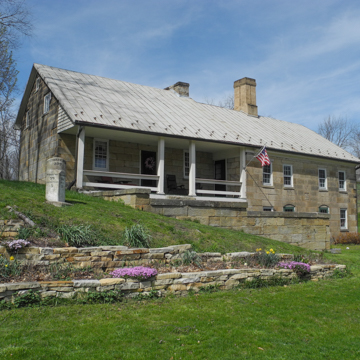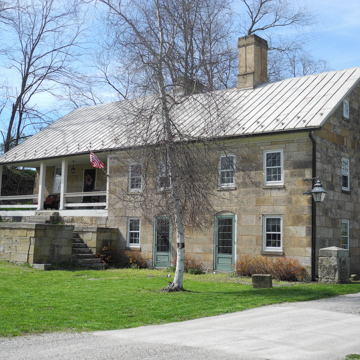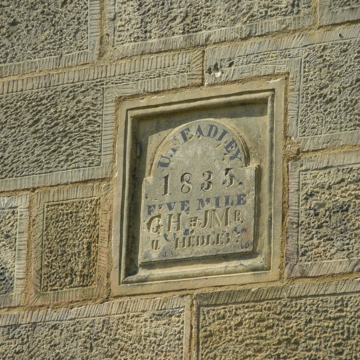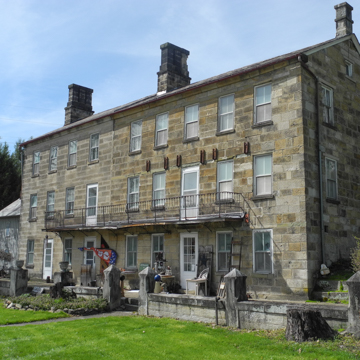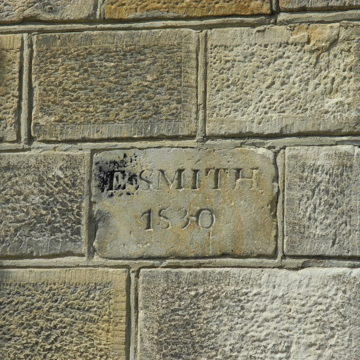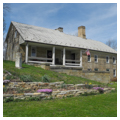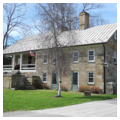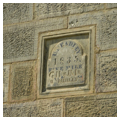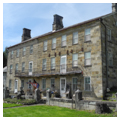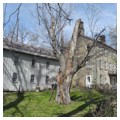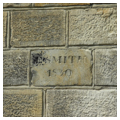The Headley Inn and Edward Smith House chart the influence of Ohio’s evolving transportation networks on the built environment from early white settlement through the mid-twentieth century. The history of these properties is intertwined with the development of the National Road, the first federally funded and planned highway in the country and a crucial gateway for settlers heading to the west.
The National Road stretched 700 miles through six states with the eastern terminus in Baltimore, Maryland, and the western in East St. Louis, Illinois. In Ohio, the more than 200 miles of the National Road were completed between 1825 and 1838, connecting Cambridge, Zanesville, Columbus, and Springfield. It provided passage to the newly developing western states and also gave Ohio farmers and producers an avenue east to sell their goods. Highway records for 1833 indicate that thousands of wagons, coaches, riders on horseback, and an enormous number of livestock traversed its route. To pay for its maintenance, the Ohio legislature authorized the construction of tollgates at twenty-mile intervals and one to each county. Existing communities along the route flourished and new pike towns sprang up. By 1837, it was reported that there were two taverns to every mile of the Road between the Ohio River and Zanesville in addition to post offices, liveries, general stores, and blacksmiths along its route.
Uzal Headley, born in Pennsylvania in 1795, arrived in Muskingum County, Ohio, in 1809. He married Elizabeth Beem in 1823 and soon became a successful businessman and landowner. In 1833 the Headleys built a two-and-a-half-story, dressed sandstone structure directly on the National Road and operated it as an inn and tavern, originally accommodating Irish laborers who built the National Road. By 1835, increased traffic along this completed stretch of National Road prompted the Headleys to more than double the size of the original building with an addition to the east side that contained one large room on the first floor, two on the second, and one on the third. The expanded inn contained eight large rooms for travelers. The interior of the addition is detailed with distinctively carved woodwork and decorative painting with grapevine and fruit designs executed by Headley’s brother-in-law, Amos Edgerly.
Just east of the Headley Inn is a stately three-story sandstone structure. Edward Smith, who arrived from Harrisburg in 1826, erected the building’s original (eastern) portion circa 1830 and, like the Headleys, operated it as an inn, frequently providing lodging to drovers traveling the National Road with their livestock. In 1860 Smith’s son, Alexander, nearly doubled the inn’s size with eight new rooms in a nearly identical addition to the west.
Throughout the middle of the nineteenth century, the Headley and Smith lodging houses provided rest and nourishment to thousands of travelers passing through southern Ohio, some heading west to the frontier, others heading east to market, and they formed part of an impressive network of commerce associated with the National Road. By the 1860s, however, their days were numbered as a growing web of railroads spread across Ohio, siphoning traffic from the once bustling highway. The inns were soon shuttered. Edward Smith bought the Headley Inn and for the next sixty years it housed his sheep-shearing operation. His own inn became a private residence occupied by Smith descendants into the twentieth century.
By then, transportation once again helped shape the fortunes of these buildings on the old National Road. The start of the twentieth century witnessed an incredible rise in the popularity of recreational bicycling, due in part to new technology in the form of pneumatic tires and consistently sized wheels and lower frames, but also to the advocacy work of the League of American Wheelmen, who lobbied tirelessly for improved road conditions as an aid to bicycle touring. By 1909, the Wheelmen partnered with the American Automobile Association, founded in 1902, which joined the Good Roads Movement. Paving the National Road west of Zanesville began in 1914 and by the 1920s, automobile and bicycle traffic on the improved highway surged. In 1922, Edward Smith’s great-granddaughters reopened the Headley Inn as a restaurant with sleeping rooms to serve a new generation of travelers along what had become U.S. Route 40. That restaurant closed in the 1960s, victim of forces similar to those that had shuttered the Headley a century earlier. Now it was the interstates offering faster, safer, and less congested routes. The construction of I-70 once again drained traffic and customers away from the old National Road.
In 1978, the Headley Inn and Edward Smith House were added to the National Register of Historic Places. The Headley Inn continued as a private residence for several decades before opening as a bed and breakfast in 2018. The Smith House, meanwhile, went through a sequence of commercial uses in the second half of the twentieth century: a restaurant, offices for an oil company, and an antiques store. It was put up for auction in 2018. Since 2000, the National Road Association has worked to interpret and promote their historical significance as commercial establishments on an historic highway.
References
Harper, Glenn, and Doug Smith. The Historic National Road in Ohio, The Road That Helped Build America. 4th ed. Ohio National Road Association, Ohio Historical Society, Davidson Trust, 2010.
Knepper, George W. Ohio and Its People. Kent, OH: Kent State University Press, 1989.
Miller, Orloff, Phd., Adrienne B. Cowden, Rita Walsh, Gray and Pape, Cultural Resources Consultants. National Road/U.S. 40 Historic Properties Inventory in Ohio Vol. I-III. 1998.
Taylor, David L. “Headley Inn, Smith House and Farm,” Muskigum County, Ohio. National Register of Historic Places Inventory–Nomination, 1978. National Park Service, U.S. Department of the Interior, Washington, D.C.

